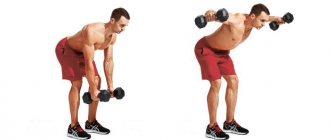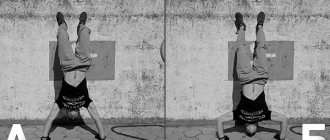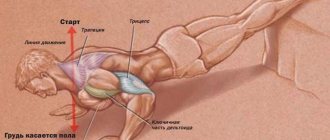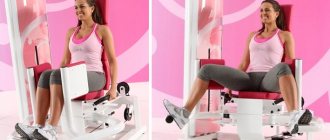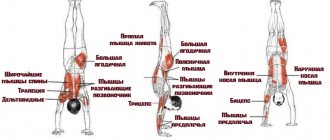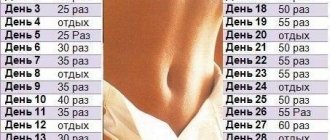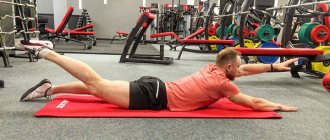Pumping up your shoulders is one of the most difficult tasks, since this group of muscles performs an auxiliary function everywhere, and it is almost impossible to work them in a targeted manner.
The rear deltoids, which cover the shoulder joint closer to the shoulder blades, are the worst to pump.
There is a special set of exercises aimed at training the shoulders with an emphasis on the posterior deltoid muscles.
This type of training is simple and accessible to everyone, because it does not require the purchase of expensive exercise equipment.
In this article you will learn how to pump up your rear deltoids at home.
Recommendations: how to pump up your rear deltoids
- In order for your shoulders to noticeably increase in volume, you need to work with more weight.
- It is important that the number of repetitions does not exceed 12 times, optimally 8-12.
- Both men and women need to feel a good load; it is the burning sensation in the muscle during the last repetitions that indicates the correct choice of weight.
- The last two repetitions must be performed with all your might - this is a very important condition.
Only if all recommendations are followed, muscle growth is ensured.
Girls do not necessarily need to develop their posterior delta with exercises in the weight training mode. The endurance mode is quite suitable - 15-20 repetitions of 3 sets, while the muscles will have a sporty and feminine appearance.
Also, do not overload , do no more than 1-2 workouts per week. Tired and overtrained muscles will not increase in volume and training will simply lose its meaning. is equally important for muscle growth, especially after training. The formation of new muscle fibers requires proteins, fats and carbohydrates. It is proteins and carbohydrates that are the building materials and energy fuel for muscles. Eat 4-5 times a day, and after training, eat food within 40 minutes, and then you will get beautiful and shaped shoulders.
Rear delt exercises
Wide, massive shoulders are one of the essential components of a beautiful male figure, so during training you should pay attention not only to the biceps and triceps, but also to the deltoid muscles of the shoulder.
Representatives of the fair sex should not forget about them, since it is the rear deltoid that makes it possible to create a harmonious figure and avoid stooping. What exercises for the rear delta allow you to achieve maximum results, and how to perform them correctly? This will be discussed further.
Description of the exercise
This exercise looks quite simple, but there are quite important and subtle nuances. If you master them, you can put a good load on your rear deltoids, isolating them to the maximum. Any upper block and ropes (such as for extension from the upper block) are suitable for this. Can be done both sitting and standing. Do what makes you feel the target muscle group better
Main features
1. It is important to twist your elbows to the sides and up. This will shift the load to the rear deltoid and reduce the load on the latissimus dorsi muscles.
2. You need to pull so as to pull the center of the ropes towards your forehead. That is, your hands should be high enough.
3. It is advisable to tilt your body back. This will create an angle at which the rear delt will work better.
4. This exercise should be done smoothly. Rocking and sudden movements will lead to the load being “spread” over a large number of muscles.
5. Try to start the movement from the elbow. Your task is not to pull the ropes as close as possible, but to move your elbows higher, to the sides and back. If you do everything correctly, the biceps and lats will hardly be involved in the work.
6. You should inhale when you release the ropes from yourself, and exhale at the end of the effort. That is, at the end of pulling yourself towards yourself.
What is the rear deltoid?
First of all, it is worth emphasizing that the main role in the formation of the shoulder (the trapezius muscle is also added from the back). This deltoid muscle consists of three bundles - clavicular, acromial and spinous.
It is the latter that is the very rear deltoid that worries so many athletes. It is worth emphasizing that this muscle is not too large in size, so it would seem that pumping it up is not difficult.
However, a problem arises here: the fact is that when performing basic exercises, only the front and middle deltas are included in the work, while the back one “relaxes.”
Thus, the athlete does not feel the load on this part of the muscle, forgets about it, and the result remains disastrous - if you look at the shoulders from the side, they do not look too massive and disproportionate compared to pumped up arms.
Special isolating exercises for the rear delta of the shoulder will help solve this problem - primarily deadlifts. This is due to the fact that the function of this muscle is pulling. She is also responsible for horizontal arm movements.
How to pump up your rear delts
- Since when performing basic training complexes there is practically no load on the posterior deltoid muscle, attention should be paid to the selection of exercises that will make this part of the shoulder work.
- Although this part of the muscle is not very large in size, it recovers quickly enough, so you can train without long pauses: up to three times a week.
- Remember that the middle delta “steals” the load from the back one - they both perform a pulling function. That is why you should carefully select exercises and listen to your own sensations - how much the back of the muscle is involved in the work.
- When performing rear delt exercises with dumbbells, it is advisable not to swing your arms until you are completely exhausted, but to use so-called drop sets, that is, train by reducing the weight, and use a small number of repetitions during each set. In this case, pauses between approaches should be very short (those who have enough strength can work without stopping).
As a rule, exercises for the rear deltas are performed with equipment - a barbell or dumbbells, but beginners can do them “empty-handed”: at the initial stage, the main task is to feel the location of the muscles.
- It is also effective to perform exercises with your arms one at a time - this will ensure that the back side of the deltoid muscle is loaded.
- Don't chase weight: start training with light equipment and only gradually move on to heavier ones.
- Please note that this muscle bundle consists of fibers that contract quite slowly. They are best developed with prolonged aerobic activity, so those who do not know how to pump up the rear deltoid should prepare for long repetitions and several approaches.
- To pump up these naughty muscles, start your workout with exercises for them. This way, you will achieve a harmonious result faster.
- You can perform a complex for the rear deltas both together with exercises for the shoulders and during back training.
- Do not forget about proper nutrition - although the bundle is small in size, it will need a significant amount of protein (in food or in the form of special protein supplements) to recover.
The best exercises for the rear delts - features and technique
To pump up your rear deltoid muscles, do exercises with dumbbells and a machine. You can also use a barbell, but it is used much less frequently.
Exercise No. 1
One of the main exercises for pumping up the rear deltoid is dumbbell lateral raises. They are performed in a tilted position and do it as follows: lean forward, fix the upper half of the body at an angle of forty to sixty degrees.
You can rest your forehead on a vertical plane or put on a power belt - this will relieve the load on the spine. The back does not have to be flat - it can be slightly rounded, this will make the exercise more effective. Pull your arms with dumbbells back without straightening your elbows or engaging your arm muscles.
It is very important that the elbow does not “sink”, but also does not lift up - the hand should move in the same horizontal plane. At the top point, tense your muscles for a second or two. The dumbbells should not touch each other at the bottom.
It is better to start performing this exercise with each hand in turn, and only after mastering the technique can you make synchronous movements with both hands. Choose light weight dumbbells. It is better to perform such lifts at a slow pace.
Exercise No. 2
The same movement can be done while sitting - with your torso resting on your hips. Try doing it on an incline bench, and choose a small angle of inclination: the smaller it is, the more actively the rear delta is involved in the work.
Exercise #3
Side raises from a low incline. This is a fairly complex exercise, so it should be performed with the proper level of preparation. Lean forward so that your forehead almost touches your knees.
Relax your hands with dumbbells and lower them - they should practically lie on the floor. To perform the lift, first turn your arms so that your palms are facing up, and only then lift your arms out to the sides. Use light weight - even this will provide the rear deltoid with sufficient load.
Exercise #4
Rear delt exercises with a barbell are less popular, but this does not reduce their effectiveness. Here is one of them: in the Smith machine, lean forward and hold the bar in your hands behind your back. Smoothly pull the barbell towards your lower back.
Pay attention to the correct execution of this pull-up: the palms should be at a short distance on the bar (at shoulder width or slightly closer), otherwise the load will be distributed to the trapezius muscle.
Be sure to lean forward and do not work with free weights - the bar may move horizontally, and the load will not reach the rear deltoid. Finally, don't lift the bar above your lower back.
Exercise #5
You can work your rear delts with a block too. To do this, use minimal weight and move your arms back, keeping your elbows parallel to the ground. Please note that the amplitude of movement should be quite short. But the grip is not of fundamental importance.
Technique: reverse flyes in the butterfly simulator
1. Adjust the position of the handles and the height of the seat of the Peck-Deck machine so that in the starting position the distance between the handles is equal to shoulder width, and the arms holding the handles are straight and parallel to the floor.
2. Take the starting position: your chest is pressed against the back of the seat, your torso is in an upright position, your back is slightly arched in the lower back, your arms are straightened and hold the handles with a neutral grip (palms facing each other). Slightly spread the handles so that the load lifts from the stops.
3. Inhale and, holding your breath, tighten your rear deltoids and upper back muscles, spread your arms as far back as possible - your elbows should be behind your back.
4. At the top of the exercise, when your arms are pulled back as far as possible, take a short pause, tighten your rear deltoids even more, and then exhale and smoothly return to the starting position.
5. Having reached the bottom point of the exercise (handles slightly wider than shoulder width, weight suspended and not touching the supports), pause for a second and proceed to the next repetition.
6. It is possible that the design of the simulator will not allow you to perform the exercise with straight arms. In this case, it is allowed to slightly bend your arms in the starting position. The main thing: do not bend or straighten your arms during the movement; the elbow joint must be fixed until the end of the set.
Reverse flyes in the butterfly-muscle simulator
Rear deltoid exercises - video
To provide this whimsical muscle bundle with a load, you do not need to perform a set of a dozen exercises. It’s enough to start training with a couple of effective movements (don’t forget about the maximum number of repetitions), and soon your shoulders will become beautiful and sculpted.
You can find out what these exercises are and how to do them correctly from the following video. The trainer will not only tell you how to perform the movements, but will also show you. The main mistakes that beginners often make are also listed, and recommendations for working this muscle are given.
Now you know how to pump up the rear delts and provide beautiful shoulder relief. You can exercise several times a week, but don’t forget about rest. When practicing exercises, pay special attention to technique - if you do them incorrectly, the load will be distributed between the triceps, anterior and middle deltoids.
Exercises for the middle delta
The middle delta of the shoulder is a synergist of the anterior and middle deltoid muscles, therefore, in principle, all exercises for the shoulders, one way or another, “hook” the middle delta, but sometimes this is not enough, so you have to select special exercises for the middle delta. What kind of exercises are these? In general, the working delta is always the one that is located above the axis of the shoulder joint, therefore, if you want to load the middle delta, then it should be visible in the mirror. Since the middle delta is a synergist of both beams, it can be trained with both presses and stretches. Many people believe that it is impossible to load the middle delta bundle with bench presses and scoff at the various variations of head presses, saying, what difference does it make where you lower the barbell? But there is a difference and it is huge!
The fact is that the main function of the deltoid muscles is to bring the scapula upward, but the bundles of deltas are attached to the scapula in different ways, and therefore, which deltoid will take the load depends on the position of the shoulder joint . If you try to lift the scapula up with your arms down, then you will lift it with the rear deltoid; if you lift your arm up, then you will be pulling the scapula with the front deltoid. The middle deltoid, which attaches to the acromion and spine of the scapula, will work as a synergist in both cases, but is easier to work with the posterior deltoid. Why? Firstly, because it is attached closer to it, and, secondly, because its innervation occurs at a different angle. In order for the middle delta to be normally innervated in the bench press, it must be shifted to a smaller angle.
Do you understand? Muscles are divided into pushing and pulling only conditionally; in fact, absolutely all muscles pull bones, therefore, when they say that the middle and rear deltoids are intended for pulling, and the front for presses, this simply speaks of the illiteracy of these demagogues. Therefore, let's fix the fact that all deltoid muscles are designed to adduct the scapula upward, and the degree of their innervation depends on the angle at which the force is applied. This is why in exercises for the middle deltoid it is necessary to change the position of the shoulder joint in such a way as to reduce the angle at which the middle deltoid muscle is attached to the shoulder blade. So what does the overhead press have to do with it?!
The point is that in the normal position, the middle bundle of deltas seems to go around the shoulder joint, so it is almost impossible to innervate it, but if you move your arm to the side, that is, raise it to an angle of 90°, and the angle of attachment of the middle delta will change. If you also pronate or supinate your arm, turning it with your palm forward or backward, then it will be even easier to tighten the middle deltoid. Look, at the starting point, when the athlete holds the barbell at ear level behind the head, the anterior bundle increases the angle of attachment, and the middle and posterior bundles decrease, so it is easier to innervate them. The problem is that not everyone has enough stretching to feel comfortable in this position.
If you have kyphosis, stoop, or a skeletal structure that does not allow you to bend your arms back normally so that they are parallel to the body, then the overhead barbell press is not your exercise. It’s a shame, since this is the only truly basic exercise for the middle delta, but still, in this case, it’s better to abandon it. Firstly, the likelihood of getting injured is too high, and secondly, in this case it will not be possible to realize the strength potential of the exercise. What to do? Do stretches with a barbell ! This is also a basic exercise for the middle delta, and it is much easier to load it, but, as a rule, it is done incorrectly.
Very often you can see how the barbell is pulled to the chin with a narrow grip, or the elbows are pulled down, which shifts the angle of the load, and this, as we found out, is the most important thing. So, in order for the barbell pull to the chin to innervate the middle deltoids, the pull must be performed with a wide grip with the elbows extended forward beyond the shoulder line. It goes without saying that pulling the barbell upward beyond shoulder level is pointless, since the angle of load increases and innervation is lost. In general, your goal in any exercise is to work in such an amplitude in which the muscle is able to produce the greatest efficiency, since everything that goes beyond the useful amplitude, from the point of view of muscle growth, is an unnecessary extra load.
In general, the pull-up and press are the two main exercises for the middle deltoid, which can also be performed with dumbbells, but if we are talking about deadlifts, then the exercise can be performed with dumbbells in a different amplitude. Dumbbells allow you to spread your arms wider to the sides, that is, pull the shoulder blade not just up, but up through the sides. Please note, do not In swings , the logic is absolutely the same as in stretching, we must pronate our hands, bring our elbows forward a little and, spreading our arms to the sides, pull the shoulder blade up.
Conclusion: to train the middle deltoid, it is necessary to minimize the angle of its attachment to the scapula, which is achieved in its own way in each specific exercise. The most effective exercise for the middle deltoid is the overhead press, but not everyone can do it, so sometimes it is recommended to replace it with a barbell pull-down. Also, training the middle bundle of deltoid muscles can be supplemented with dumbbell swings to the sides. Remember that the choice of exercises depends on the specific training system and the genetic characteristics of the athlete.
Pumping up the rear deltoid
Many people who go to gyms neglect pumping up the rear deltoid. Like, why bother with it, it’s invisible. Yes, no doubt, the basis of a bodybuilder’s appearance is the abs, arms (biceps, triceps), and chest. And after them they pay attention to the back and legs.
But even if you are not going to compete, you still need to pay attention to this muscle. After all, without a developed rear delta, it is impossible to achieve a spherical appearance of the shoulders. Let's look at how to pump up the rear deltoid.
Functions and anatomy of the deltoid muscle
The usual division of the deltoid muscle mass into posterior, anterior and middle (sometimes called external) is very arbitrary. More precisely, these are different bundles of muscle fibers of one muscle. These beams and their features will be discussed. For simplicity, from now on they will simply be referred to as the posterior, anterior and middle deltas.
This muscle works during various arm lifts. Raising to the sides works the middle deltoid, and raising the arm in front of you works the front part. The back part lifts the arm in a horizontal plane. The deltoid muscle also contributes to the barbell press (as an auxiliary muscle) and is involved in shoulder rotation.
In 2002, an extremely interesting study was carried out. Scientists compared the size of the deltoid muscle in untrained people and in bodybuilding athletes. According to published data, the anterior delta is five times larger in a bodybuilder compared to an average person. The middle part of the delta is three times larger, and the rear is only ten to fifteen percent.
Upon careful examination of the data, a bias in the development of various muscle bundles becomes noticeable. The reason can be found in the standard training program. After all, the main exercise is always the vertical press. Everything else is secondary, just for isolation.
At the same time, athletes believe that in this way they pump all parts of the deltoid muscle. It is believed that the standard chest press pumps up the anterior bundle. When pressing dumbbells, the middle fibers are worked out. If you perform a barbell press from behind your head, then not only the middle, but also the back part of the delta is pumped.
Unfortunately this is not entirely true. With all of these exercises, the front part of the deltoid muscle is worked first. And the rest work only as auxiliaries. The same can be said about such a popular exercise as the “Arnold press.” That's why there is such a skew in development.
But you can fight this. To do this, it is enough to dilute the presses with exercises with dumbbells. And first of all, raise your arms from the sides.
What to take as a basis
Before giving advice on choosing exercises to load the middle delta, you should clarify the fact that not all lateral arm raises are useful specifically for this muscle bundle. It can only be pumped effectively using horizontal lifts. That is, when the athlete’s torso is at a large angle.
The exercise should be considered ideal if the athlete bends over until his torso is parallel to the floor. In order to reduce the load on the lower back, it is necessary to use a special belt. And it will be even more reliable to perform it with your head resting on any convenient support, which can be, for example, an inclined bench.
Another popular, and also very convenient and effective way to perform this exercise is seated bent over arm raises. To do this, you need to sit on a bench, lie with your stomach on your knees and do lifts from the sides.
Unfortunately, the last version of this exercise is not suitable for everyone. Problems with performance may arise due to a large belly. Also, not everyone’s spine is flexible enough to lie completely on their knees.
You can also simply lie on an inclined bench, and you can lie either face down or on your back. Moreover, the closer to the horizontal position, the more the posterior muscle bundle is pumped. At an inclination angle of more than forty-five degrees, the middle delta is pumped up more, but the back of the muscle also works.
Low bow
The hardest way to perform lateral raises is to bend forward to the maximum. Ideally, reaching your face to your knees. This option is not suitable for everyone, because not everyone is able to turn out this way. When performing it, it is better not to use too much weight, and with small dumbbells this exercise will not seem easy to you.
Also, many athletes and coaches recommend a more complex version of raising your arms. To do this, you should rest your head against the back of the inclined bench, while bending below the horizontal. With this design, efficiency increases many times over.
In modern bodybuilding there are practically no places left where exercise machines are not used. There is also a specialized unit for pumping the delta. This is a simulator designed for the rear delta with a rather beautiful name - reverse butterfly. It is likely that this is not the only option, but you won’t find others in the halls.
With the help of this projectile you can easily pump up the posterior muscle bundle. There are two ways to use this simulator. With one, the palms look inward, with the other, outward. The right one for you will be the one after which you will feel the delta more strongly.
Unfortunately, this simulator is almost a museum rarity. But it can easily be replaced with a regular crossover. In this case, you can work with both the lower and upper blocks. The only thing that needs to be noted is that when working with the lower block, you get the same bent over arm raises. Just without dumbbells.
Before performing exercises on a high block, it is advisable to prepare the apparatus for work. Preparation consists of removing the handle from it. In principle, if you feel more comfortable working with them, then you can leave them on.
After this, grab the stops or handles with your hands and begin to cross your arms. During these movements, you need to lean back as much as possible. If it is possible to use a paired block, then you can work with neighboring crossovers. This will increase the positive effect. Ideally, to achieve a greater load on the muscles being worked, it is better to work not while standing, but on a bench.
Alternative view
All of the above methods of training the deltoid muscle are common and can be found in almost any gym. But there is another, very unusual view on delta training. Some fairly respected athletes have made themselves rounded, even shoulders without bending or using exercise machines.
Alexey Shabun can easily be considered such athletes. This method of training brought him quite good results. To pump up the rear deltoid, he uses a Smith machine. To do this, he stands with his back to him and performs lifts of the barbell behind his back to the height of his lower back. Only the posterior delta fibers work this way.
Without a Smith machine, doing this exercise is useless. After all, for proper execution, the bar should not move horizontally. With such a displacement, the trapezoids will take on the load. And with free weights it is almost impossible to avoid such a turn.
The grip width and amplitude of execution are also important. Do not grab the bar with a grip wider than your shoulders. It is also important not to lift the barbell above your lower back. If the grip is too wide and the lift is high, the load will be redistributed to the trapezius, which in this case is undesirable.
Reps and Weights
There is a widespread belief that it is necessary to work with heavy weights when building up the delta. Although this approach is fundamentally wrong. After all, the entire deltoid muscle, any of its bundles, consists of slow-twitch fibers. It follows from this that this muscle requires work “for wear and tear”.
It follows from this that the most effective way to train the rear deltoid will be somewhere between fifteen and twenty repetitions. Of course, this does not mean that you should completely throw heavy weights. Sometimes you can work with weights that you can’t handle more than five times, but this shouldn’t become the norm. Such training can be used occasionally and only to diversify the process.
It is also necessary to perform as many approaches as possible. Deltas simply need to be starved out. The number of sets should not be less than ten, but preferably there should be 12-15. Otherwise, all your efforts will not be crowned with success.
For high-quality work on the rear and middle deltas, it is better to set aside a separate day. On this day you will only perform exercises for these two bundles. It’s better to take bent-over dumbbell raises as a basis. You can also do a rear exercise on a Smith machine. After completing this basics, you can finish off the muscle using a block. Thus, it is better to train once a week.
If you work like this, then after a few months of hard work on your body, you will have rounded shoulders. The main thing to remember is that the results of delta training are not immediately noticeable.
Many people who go to gyms neglect pumping up the rear deltoid. Like, why bother with it, it’s invisible. Yes, no doubt, the basis of a bodybuilder’s appearance is the abs, arms (biceps, triceps), and chest. And after them they pay attention to the back and legs. But even if you are not going to compete, you still need to.
Anatomy of the deltoid muscle
The deltoid muscle is like a cover that fits over the shoulder joint from above, like a shoulder strap.
It is this muscle that gives the shoulder its roundness and smooth shape.
The delta is heterogeneous - bundles of protein fibers intertwine at different angles, which contributes to the division of the muscle into lobes, bundles or sections. Each part of the deltoid muscle performs its own task.
Main function of each part:
- Anterior delta – flexion of the shoulder and its movement “inward”, as a result, the arm is raised.
- Medium – arm abduction.
- Posterior – extension of the arm and simultaneous rotation of the arm to the outside, resulting in lowering of the raised limb.
Posterior deltoid training program
Productive and popular exercises for the rear delta of the shoulder are pull-ups, weighted bendings, vertical pull-downs, and T-bars. A standard set of exercises affects the front and middle bundles of muscles; accordingly, the back part lags behind in development over time. Also, the posterior heads of the deltoid muscles may not grow for other reasons:
- during training it is difficult to feel the muscles of the posterior bundles
- during training, the side beam is able to take the load from the back one and, therefore, pump up much faster
How to pump up your rear delts using pulley rows?
Pull the handle of the block towards you smoothly, avoiding sudden movements, and your elbows should not deviate. Start your first rear delt pull-down exercises with 3 sets of 12 repetitions, gradually increasing the load to 5-6 sets of 12-15 reps.
Rear delt exercises with dumbbells
Before you start doing bent-over exercises, it is important to choose the optimal weight of dumbbells for yourself. That is, choose the weight of the projectile so that after 12 repetitions the muscles are not overloaded, but it should not be too easy either. You should exercise at a slow pace, this will allow you to pump up the back of the deltoid muscles.
How to pump up the rear delts using reverse wiring?
The workout is similar to the previous one, but there are some differences. The exercise is performed lying on a bench, with your arms outstretched (palms facing down). When extending your arms with a weight to the sides, your hands should be rotated 90 degrees. 3 approaches of 12 times are enough.
Exercises for the middle deltoids
To get wide and athletic shoulders, perform exercises for the middle deltoids.
Seated dumbbell press
The main load in this exercise for the deltas goes to the middle beam. Unlike bent over reverse flyes, this is not an isolation exercise. The dumbbell press is a multi-joint exercise and involves the following muscles: the anterior, posterior and middle deltoids, as well as the triceps brachii. The exercise can also be performed standing.
- Hold dumbbells with an overhand grip at shoulder level;
- Push the dumbbells over your head, exhaling at the top;
- As you inhale, lower to your shoulders;
- Perform 4 approaches. The number of repetitions per mass is 8-12.
Barbell row to the chin
This basic exercise is intended mainly for the middle delta. The main load falls on the middle deltoids, although both the anterior and posterior deltas work, as well as the trapezius muscle. When pulling a barbell to the chin, the biceps and forearm are also involved. The abdominal and buttock muscles work to stabilize the body position.
- Grasp the barbell wider than shoulder-width apart, with your feet apart;
- As you exhale, lift the barbell toward your chin from your hips. Elbows as high as possible;
- Lower the barbell toward your hips while inhaling as you move.
Smith overhead press
This is another basic exercise for the middle deltoids, which also includes additional muscles: triceps, rhomboids, upper trapezius. This technique must be performed 8-12 times, 4 approaches in total.
- Take a vertical sitting position so that the bar passes in a straight line from behind your head. Do not arch your spine;
- Perform a barbell press, exhaling towards the end of the movement;
- As you inhale, return the bar to the middle of the back of your head.
Swing dumbbells to the sides while sitting or standing
This version of the basic exercise works the middle delta, as well as the trapezius muscle.
- Lower your arms freely along your body;
- Exhale and swing to the sides until you reach shoulder level. If you want to engage the trapezius more, perform the movement above the shoulders.
- Inhale and lower the dumbbells to the starting point.
Important! Don't forget to work your rear delts, perform bent-over dumbbell swings or dumbbell and barbell rows. Remember that only the uniform development of all shoulder beams will form beautiful, athletic deltoids.
How to pump up your rear delts at home
If you do not properly train the muscles of the rear deltas, then the shoulder girdle will look underdeveloped. At home, it is difficult to achieve the desired results, especially when it comes to creating a powerful, proportional body, since it requires constant supervision from an experienced trainer.
To perform exercises at home, you will need collapsible dumbbells, thanks to which you can freely install any weight. In order for training at home to be effective, it is necessary to observe the regularity and intensity of exercise, sleep and rest patterns, and also eat properly.
As the main exercises for the rear deltas at home, it is recommended to choose the “Arnold Press” - 2 sets of 7 times; raising arms in a standing position - 2 sets of 10 times; Bent-over raises – 2 sets of 8 reps. The total duration of training should be at least 5 weeks.
Principles of rear delt training at home
- High intensity - perform 1 basic exercise and 2-3 auxiliary exercises. At the end of each exercise, stretch the loaded muscles.
- A competent split - you should pump the rear deltoids and pectoral muscles on different days, it is better if the interval between them is at least 2 days. This will allow you to give 100%.
General principles of rear delt training
- Change your training program and alternate exercises for the rear deltas so that the muscles do not have time to adapt to the load.
- The deltoid muscles are primarily composed of slow-twitch fibers that respond with hypertrophy to high repetitions. Therefore, when performing exercises, rely on high-repetition sets, but from time to time do not forget to shock your muscles with impact weights.
- Don’t put off training your rear deltoids until the end of your workout if they are lagging behind. Try doing exercises for this muscle group immediately after arriving at the gym: this way you can take more weight and work the posterior bundle with maximum impact.
- The rear deltoid is often included in the work during back exercises. Take this fact into account so as not to overload the back bundle.
deltoid rear deltoid shoulders
How to quickly pump up your rear delts?
It is known that basic exercises for the rear deltoids are better for building muscle mass, but this applies more to large muscle groups. Basic exercises include deadlifts - barbells, dumbbells, T-bars, vertical blocks, etc. Isolation exercises are more effective because they allow you to pump a specific muscle group. The following isolation exercises are suitable for developing the rear delts:
- dumbbell swings in an inclined position
- wiring in the simulator
On a note! The result will be noticeable when you learn to feel the burning and contraction of muscles.
Exercise “rear delt swings with dumbbells”
Simple tips that will help you achieve positive results in a short period of time.
You should start with a light weight - this will allow you to monitor the amplitude of movement of the sports equipment at each point.
- Do not bend more than 60 degrees, otherwise the load will be transferred to your back.
- Learn to “turn off” your forearms - this will allow you to maximally load your rear deltoids.
- Try using drop sets - for example, 1 approach, weight of the projectile 15 kg - 10 repetitions, 2 approach, weight of the projectile 10 kg - 7 times and 3 approach, weight of the projectile 5 kg - as many times as possible. There should be no rest between approaches. It is enough to carry out 4 drop sets at a time.
- When lifting the dumbbells up, hover in this position for at least 2-3 seconds.
- If you are not yet able to swing the rear delt with dumbbells, then you can perform regular swings with your arms in an inclined position - this will teach you to feel which bunch of deltas is working at the moment.
- In order to understand how the back of the muscles works, start exercising with one hand. This way you can concentrate on a specific beam and build it up more actively.
The role of exercise machines for pumping the rear deltas
To pump up the rear bundles of deltoid muscles, there is a special simulator - “reverse butterfly”. To achieve visible results, it is necessary to correctly perform the rear deltoid exercise in the simulator, especially for the arms. An alternative option is a traditional crossover. The effect is guaranteed if you exercise on the upper block. It is enough to remove the handles from the block and grab the stops themselves. The further you can lean back, the better for the deltas.
The best exercises for the middle deltas
To understand which exercises for the middle deltoids will be the best, you need to know in general terms the anatomical structure of this muscle group.
The middle section of the deltas is attached to the acrominal region of the scapula and is located between two other bundles of deltas. It should be remembered that between the sections there is a tendon that separates them from each other. The middle section of the deltas is designed to abduct the shoulder in a horizontal plane and to the side. Thus, knowing the functional purpose of the target muscle, we can determine the necessary exercises for the middle deltoids. Note that these movements are quite complex from a technical point of view and at first you should use light weight sports equipment. This way you can master their technique and minimize the risk of injury.
Arnold press
To perform this exercise for the middle deltas, you need to take a sitting position.
It is important that the surface is hard and you have maximum stability. The weight of the dumbbells should be chosen so that you can do 8 to 12 repetitions. Taking sports equipment in your hands, place them in front of you, with your palms facing inward. After this, begin to lift the shells up and at the same time turn them 180 degrees. In the uppermost position of the trajectory, you should pause for 2 seconds and then return to the starting position. Make sure that your back remains straight throughout the entire set with a natural arch in the lumbar region.
Barbell overhead presses
Like the previous movement, barbell overhead presses are basic.
At the same time, the Arnold press is somewhat less effective, but safer. Also remember that when performing overhead barbell presses, in addition to the middle section of the deltoids, you also use the front one. Beginning athletes should perform this exercise for the middle deltoids in a Smith machine to minimize the risk of injury. You can work both sitting and standing. Taking the barbell, lower it behind your head and hold it approximately in the middle of the back of your head.
After this, squeeze the projectile up and remember that in the lower extreme position of the trajectory, the elbow joints should be spread apart, forming a straight line. To avoid injury, do not lower the projectile below the optimal location of the elbow joints. As we have already said, barbell overhead presses are an effective exercise for the middle deltoids, but they are quite traumatic.
Dumbbell swings in a standing position
This movement is isolated, since only the shoulder joint works when performing it.
This has not only its advantages, but also disadvantages. The positive aspects of this movement include the emphasis of the load on the middle deltas. But at the same time, you will not be able to use heavy weights, which is a negative factor. Take dumbbells in your hands and lean forward slightly, lowering your shoulder joints. It is very important that the inclination is minimal, otherwise the load will shift to other muscles. From this starting position, begin swinging to the sides. However, do not try to lift sports equipment very high. It is enough to bring the dumbbells to the level of the shoulder joints. If you raise your arms higher, the trapezoid will come into play and take away part of the load from the deltas.
In addition, you must monitor the position of the projectiles. In the highest position, the dumbbells should seem to hang in your hands. Do not try to hold them with maximum strength and lift them to the level that you are able to hold dumbbells. You may have thought that this exercise for the middle deltoids is technically easy, but in practice this is not the case.
Pumping the rear delts with professionals
The best exercises for the rear delts from Denis Semenikhin
You can pump up gorgeous deltoids in different ways, but sometimes not everyone has sports equipment (dumbbells, barbells, etc.) at hand.
In the video, Denis clearly demonstrates how to train the deltoid muscles without sports equipment. The exercise “barbell press” (in the absence of sports equipment, you can use a stone weighing no more than 40 kg) is performed lying on a bench for 2 sets of 5-6 times. When performing the exercise, an important point is to exhale while lifting. A close-grip push-up from a bench is suitable as a finishing exercise. After a 15 second break, we switch to overhead presses in a standing position. We finish the workout with push-ups from the floor, head down.
Advice: train intensely, combine exercises in groups, train adjacent muscle groups so that the divisions between them become clearer.
Exercises for the rear deltas from Yuri Spasokukotsky
Exercise: Smith machine rear delt row. A bench is necessary in order to remove the load from the spine. You can also use a power belt to avoid injury. When performing deadlifts, you do not need to retract your shoulder blades because the rear deltoids lose load. For starters, 3 sets of 15 repetitions will be enough, and for experienced ones - 15 warm-up times and 3 sets of 6-8 repetitions. You should take a short break between approaches, otherwise you can seriously tear your muscles.
Tip: It is not recommended to work out one muscle group more than once a week. But you should train efficiently and intensively.
A slightly rounded back when performing deadlifts, as well as a head lowered all the way down, gives the posterior muscle bundles a colossal load. The lower the inclination of the bench, the higher the load on the deltoids.
Exercises for the anterior deltas
These exercises for the front deltas will work well and form a round shoulder shape at the front.
Bench press in front of you while standing or sitting
The exercise is performed in a Smith machine or with free weights and loads the anterior deltoids. This is the best exercise for the front delts, it is also basic, since it involves two joints at once - the shoulder and elbow.
- Your task is to place an incline bench (angle 75 degrees) so that the barbell press is performed from the collarbones without touching the chin (the option of pressing with a straight back is allowed). Using a wide grip, push the bar out while exhaling;
- Slowly lower the bar onto your collarbones, without touching, while inhaling.
- To increase the volume of the front deltoid, perform bench presses with heavy weights for 4 sets, each for 8-12 repetitions.
Army press
Another basic exercise for the front delts, performed with a barbell. If you need to make your technique easier, you can do the seated press.
- Take a position that is comfortable for you, grasping the barbell with an overhand grip across the width of your shoulder joints;
- Starting position – the hands are located at the front deltas. Elbows point down;
- The bar is pushed out as you exhale, the top point of the movement is the barbell above your head;
- Returning to the lowest point is accompanied by inhalation;
- When working to increase mass, 4 sets are performed 8, 10 or 12 times.
Raising dumbbells in front of you while sitting or standing
In this exercise, the load falls specifically on the front deltoids. The exercise is also performed standing, provided that your body does not help with unnecessary swinging.
- In a sitting/standing position, your arms are lowered with dumbbells along your torso. Elbows should be slightly bent;
- Swings with both hands (can be done alternately) are accompanied by an exhalation to the line at eye level, first the hands are turned in the middle of the amplitude, the hands and forearms are in the same plane;
- Lower it inhale;
- Still working 4x8-12.
Front beam in Crossover
The exercise can be performed with a straight handle from a lower block, or with ropes, the main thing is to follow the correct technique. This option can replace swings with dumbbells in front of you.
- Keep the handle straight with your back to the Crossover, without moving far from the block. Step over the cable with one foot, ensuring that the block moves in the center;
- As you exhale, raise your arms to eye level. Keep your back straight. You can move your body forward a little;
- Lower the handle as you inhale toward your hips.
- Repeat 8-12 times for all 4 approaches.
Training the rear deltoid muscles - conclusions and recommendations
Above we looked at what the rear delts are and how they can be effectively pumped up with exercise. For beginners, experienced athletes recommend going to the gym first. Once you master all the intricacies of training, you can safely alternate training in the gym and at home. To increase the muscle mass of the rear delts, it is not necessary to train with heavy weights. The intensity of the movements is important.
- learn to feel the tension of the pumped muscle group
- choose gentler exercises for the first time
- keep your technique under control
- When bending with an apparatus, avoid “deep” bends
- do your workout smoothly
- do not forget about the warm-up part before training
- the rear delts are able to recover quickly, so they can be pumped 2-3 times a week.
